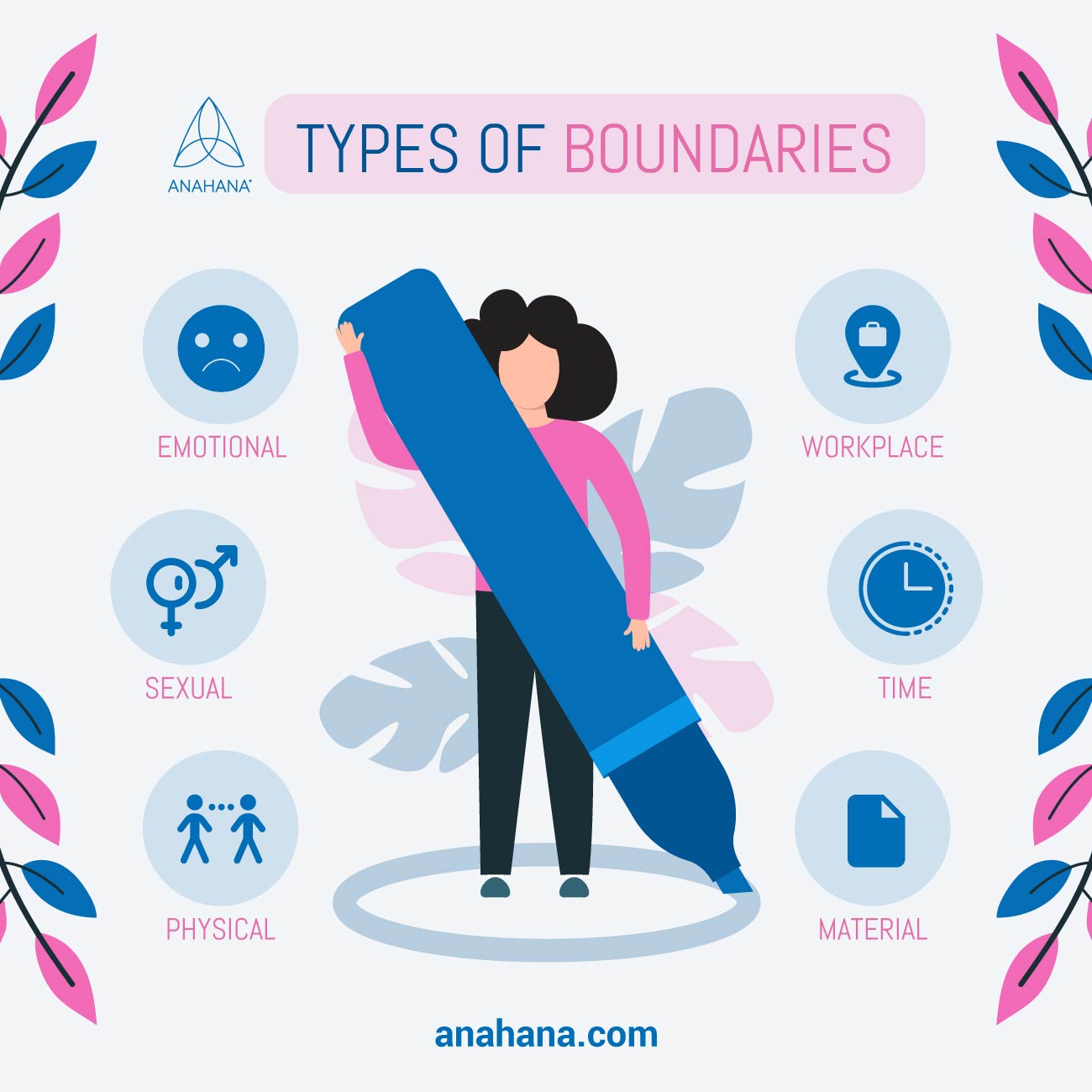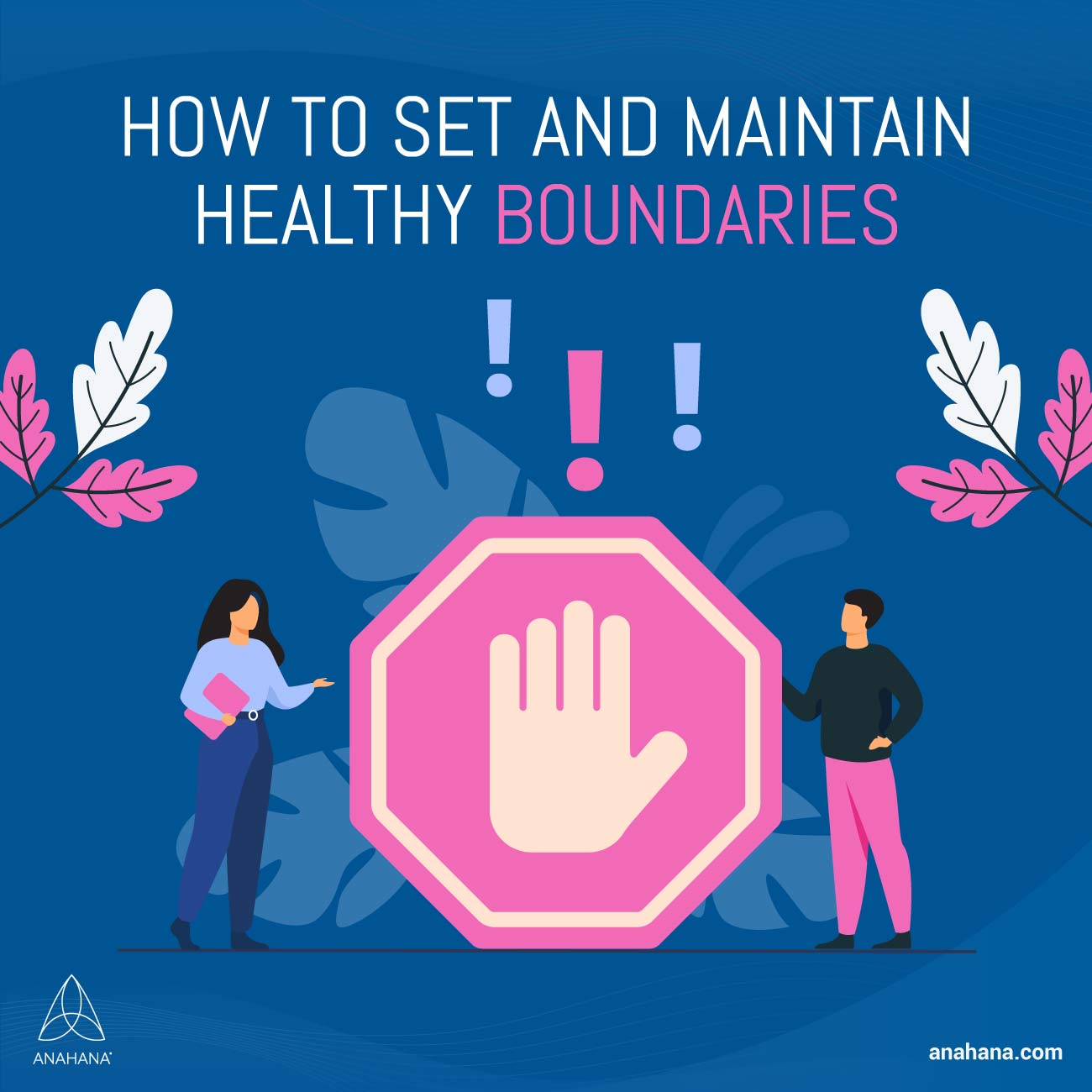
Table of Contents
Boundaries are the foundation of healthy relationships but are not easy to establish. Learn more about what personal boundaries are, the types of boundaries and some helpful tips for setting and communicating boundaries.
What are Personal Boundaries?
Personal boundaries refer to the limits or boundaries individuals establish in response to their own emotions, comfort levels, and interpersonal situations. These boundaries can encompass personal space, verbal communication, and physical contact.
Boundaries can be present in various settings, such as the home, workplace, or when socializing with friends. In any situation, individuals are likely to have personal boundaries determined by the situation's context.
It is important to note that personal boundaries can exist without any explicit communication. Everyone has their own individual boundaries, regardless of whether or not they choose to express them to others. Still, personal boundaries are at risk of violation if people do not communicate them directly, leading to discomfort or harm.
Why are Boundaries Important?
Each individual has their own personal boundaries, and it can be challenging to understand and respect others boundaries. Personal boundaries are crucial in how individuals navigate their lives and relationships. Setting and communicating boundaries is important to maintain relationships and ensure individuals can express their feelings and needs. Relationship boundaries define each person's responsibilities, how they perceive each other, how they interact, and whether both partners feel respected and safe.
While individuals may not always agree with or comprehend another person's boundaries, it is essential to establish boundaries to create clear expectations and limits. It takes courage and strength to communicate one's boundaries to others.
Maintaining healthy boundaries is also vital for one's mental well being. Individuals with well-defined boundaries and the ability to communicate them tend to experience higher self-esteem, emotional well-being, and lower stress levels than those with unhealthy boundaries or no boundaries at all.
Blurred boundaries between home and work life link to lower levels of happiness, unhealthy lifestyles, and a greater risk of conflict. Setting appropriate boundaries in both personal and professional settings is essential to ensure a balanced and fulfilling life.
Types of Boundaries
 Boundaries can fall into various categories and individuals must decide the type of boundary they want to set. There are different boundaries that individuals can establish in their personal and professional lives. Here are some examples:
Boundaries can fall into various categories and individuals must decide the type of boundary they want to set. There are different boundaries that individuals can establish in their personal and professional lives. Here are some examples:
Emotional Boundaries
Emotional boundaries are essential for protecting one's emotions and how others communicate with and treat them. Unfortunately, it is common for individuals only to realize their boundaries have been crossed after the fact.
Communicating with the other person involved is the most effective approach to establishing emotional boundaries after a conflict or argument. This involves expressing how one feels about the behavior that crossed the boundary, taking responsibility for any mistakes made, and discussing the disagreement to address any issues that may have contributed to the conflict.
Sexual Boundaries
Individuals must establish sexual boundaries when entering new intimate relationships or expanding existing ones. Establishing these boundaries in relationships can be done through an open and honest conversation with one's partner. Individuals can ensure a healthy and respectful relationship by setting clear boundaries early on and communicating any discomfort.
Physical Boundaries
It is common for individuals to have varying levels of comfort with social norms, such as physical interactions like shaking hands. The degree of physical intimacy an individual is comfortable with in different social contexts or public spaces may depend on their culture or personality. The most effective way to deal with this situation is to set clear boundaries before problems arise.
Many individuals might not be comfortable with social norms like shaking hands or their physical interactions with others. The level of physical intimacy an individual is comfortable with in public spaces or in various social contexts can depend on one’s culture or personality. Communicating what makes individuals feel uncomfortable is critical to maintain healthy boundaries.
Workplace Boundaries
Setting professional boundaries in the workplace involves establishing how one wants to conduct themselves professionally and the behavior one expects from others during interactions.
Effective communication of work boundaries and discussing conflicts with co-workers can foster healthy relationships in the workplace. If an individual's boundaries are persistently violated or disrespected in the workplace, it is appropriate to involve human resources to address the situation.
Time Boundaries
There are two groups of people based on their approach to punctuality and time management. Some individuals are chronically late, while others consider anyone arriving at the agreed-upon time late. This can lead to feelings of disrespect and boundary violations.
To manage this situation, it is important to have open communication with individuals who are frequently late. This may involve setting a time limit for waiting and letting them know that one cannot wait beyond the agreed-upon time. By communicating clearly and establishing time boundaries, one can avoid wasting time, manage their schedule effectively, and maintain a healthy relationship.
Material Boundaries
Material boundaries are related to an individual's personal belongings, such as clothing, cars, money, jewelry, and furniture. It is essential to set healthy boundaries about how and with whom these materials can be used or shared and how one expects others to treat their possessions.
Creating and maintaining material boundaries can protect individuals from losing or damaging their belongings and prevent others from using them to manipulate or control relationships. By setting and enforcing these boundaries, individuals can promote respect for their possessions and themselves.
Intellectual Boundaries
Intellectual boundaries involve acknowledging and respecting other people's ideas, thoughts, and opinions. It is important to be open-minded and willing to communicate with others, even during disagreements. Disrespecting others' intellectual boundaries can involve dismissing their ideas or refusing to consider their perspective.
How to Set and Maintain Healthy Boundaries?
 Self-awareness is a crucial step in setting boundaries. Individuals should be clear about their expectations of themselves and others and their comfort levels with social situations and individuals. With greater self-awareness, individuals can establish healthy boundaries. Clear communication is necessary for setting boundaries effectively. It is important to convey one's feelings to others, especially when setting and communicating new boundaries.
Self-awareness is a crucial step in setting boundaries. Individuals should be clear about their expectations of themselves and others and their comfort levels with social situations and individuals. With greater self-awareness, individuals can establish healthy boundaries. Clear communication is necessary for setting boundaries effectively. It is important to convey one's feelings to others, especially when setting and communicating new boundaries.
Asserting one's priorities and needs is a form of self-love, and there are three steps to setting healthy boundaries. The first step is to be as straightforward and transparent as possible without raising one's voice.
The second step involves stating one's needs and requests directly regarding preferences and likes. The third step is accepting any guilt, remorse, shame, or discomfort arising from setting boundaries. This is especially crucial for individuals with codependency, people-pleasing tendencies, or those struggling to set poor boundaries. Setting poor boundaries can increase the likelihood of boundary violations.
When setting one's own boundaries, individuals must recognize that they can set boundaries to feel safe and ensure that others understand their limits.
Frequently Asked Questions
What are Healthy Boundaries In a Relationship?
Healthy boundaries in a relationship refer to limits and guidelines that partners establish to protect their physical, emotional, mental, and spiritual well-being. Healthy boundaries help partners communicate their expectations, values, and needs while respecting each other's autonomy and individuality.
Healthy boundaries help partners establish a sense of trust, respect, and mutual understanding and avoid toxic relationships. Some examples of healthy boundaries in a relationship include:
- Communication
- Personal space
- Emotional boundaries
- Physical boundaries
- Financial boundaries
- Sexual boundaries.
How Do I Establish Healthy Boundaries When Dating?
Establishing healthy boundaries is an essential aspect of dating. Here are some steps to help one establish healthy boundaries:
-
Know one's values and needs: Before entering into a dating relationship, people should know their values and needs.
-
Communicate one's boundaries: Once one is clear about their values and needs, they should communicate them to their partner.
-
Be consistent: Once one has communicated their boundaries, it is essential to be consistent in enforcing them.
-
Respect one's partner's boundaries: Just as it is important for one to establish their own boundaries, it is equally important that they respect their partner's boundaries.
-
Be open to negotiation: While it is important to establish and enforce boundaries, it is also important to be open to negotiation in setting better boundaries.
What are Healthy Boundaries with Parents?
Establishing healthy boundaries with parents can be challenging, particularly when there is a history of over-involvement or enmeshment. Clear communication is crucial to set healthy boundaries with parents. The individual should let their parents know which behaviors are acceptable and which ones are not in a respectful manner.
Assertiveness is key when it comes to enforcing boundaries that are being violated. It is necessary to be firm in consistently standing by and communicating these boundaries. Additionally, the individual should know what triggers them and causes discomfort. This can assist them in setting clear boundaries and communicating them effectively.
Saying "no" is an essential aspect of setting boundaries. It is okay to refuse invitations or requests that do not align with one's values or priorities. Taking care of oneself is also important. Prioritizing one's well-being may involve limiting contact with parents or seeking family therapy to resolve any issues. Setting boundaries with parents may require patience and persistence, but it is necessary for personal growth and well-being.
References
How to Set Healthy Boundaries & Build Positive Relationships
The Guide to Strong Relationship Boundaries
The No BS Guide to Setting Healthy Boundaries in Real Life
6 Types Of Boundaries You Deserve To Have (And How To Maintain Them)
DISCLAIMER
The contents of this article are provided for informational purposes only and are not intended to substitute for professional medical advice, diagnosis, or treatment. It is always recommended to consult with a qualified healthcare provider before making any health-related changes or if you have any questions or concerns about your health. Anahana is not liable for any errors, omissions, or consequences that may occur from using the information provided.

By: Anahana
The Anahana team of researchers, writers, topic experts, and computer scientists come together worldwide to create educational and practical wellbeing articles, courses, and technology. Experienced professionals in mental and physical health, meditation, yoga, pilates, and many other fields collaborate to make complex topics easy to understand. Anahana is also home to specialists in crystals, tarot, angel numbers, astrology, life path numbers, zodiac signs, and horoscopes. By combining evidence-based wellness with spiritual and energetic practices, the team offers clear, trustworthy guidance for both mind-body health and modern spirituality.